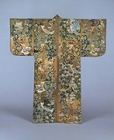Japanese Gallery (Honkan) Room 9
September 15, 2009 (Tue) - November 8, 2009 (Sun)
Many Noh plays are poetic portrayals of the inner selves of people in the middle Ages at tragic scenes. Noh is neither like Kyogen theater, where comic aspects of daily life are told, or the dramatic representations of Kabuki. Actors express the character and class of their roles as well as emotions such as joy, sorrow and regret in restrained movements and verse.
Since exaggerated gestures and facial expressions are omitted in Noh performances, the subtle expressiveness of masks has a substantial importance. In masks for female roles, for example, the basic form is the koomote mask for young women, and the characters' ages, nature, and situations are carefully represented by details such as disheveled hair, gazing eyes, or wrinkles. They are a result of an aspiration to embody the expressions of women - a challenging aspect for the actors, being men.
Costumes of Noh, unlike masks, are not governed by rules depending on roles. For instance, the selection of karaori robes, which symbolize female characters, is left to the actors themselves. Courtly designs such as phoenixes, bamboo blinds and poem cards signify elegant noble women, whereas subdued designs such as autumn grasses are chosen for ordinary townswomen. Designs of Noh costumes can be seen as an important feature of each stage production.
In Noh, the selection of masks and costumes by the actors bring individuality to the appearance and character of female roles. This exhibition aims to provide a look into the intricate representations of women in Noh.

